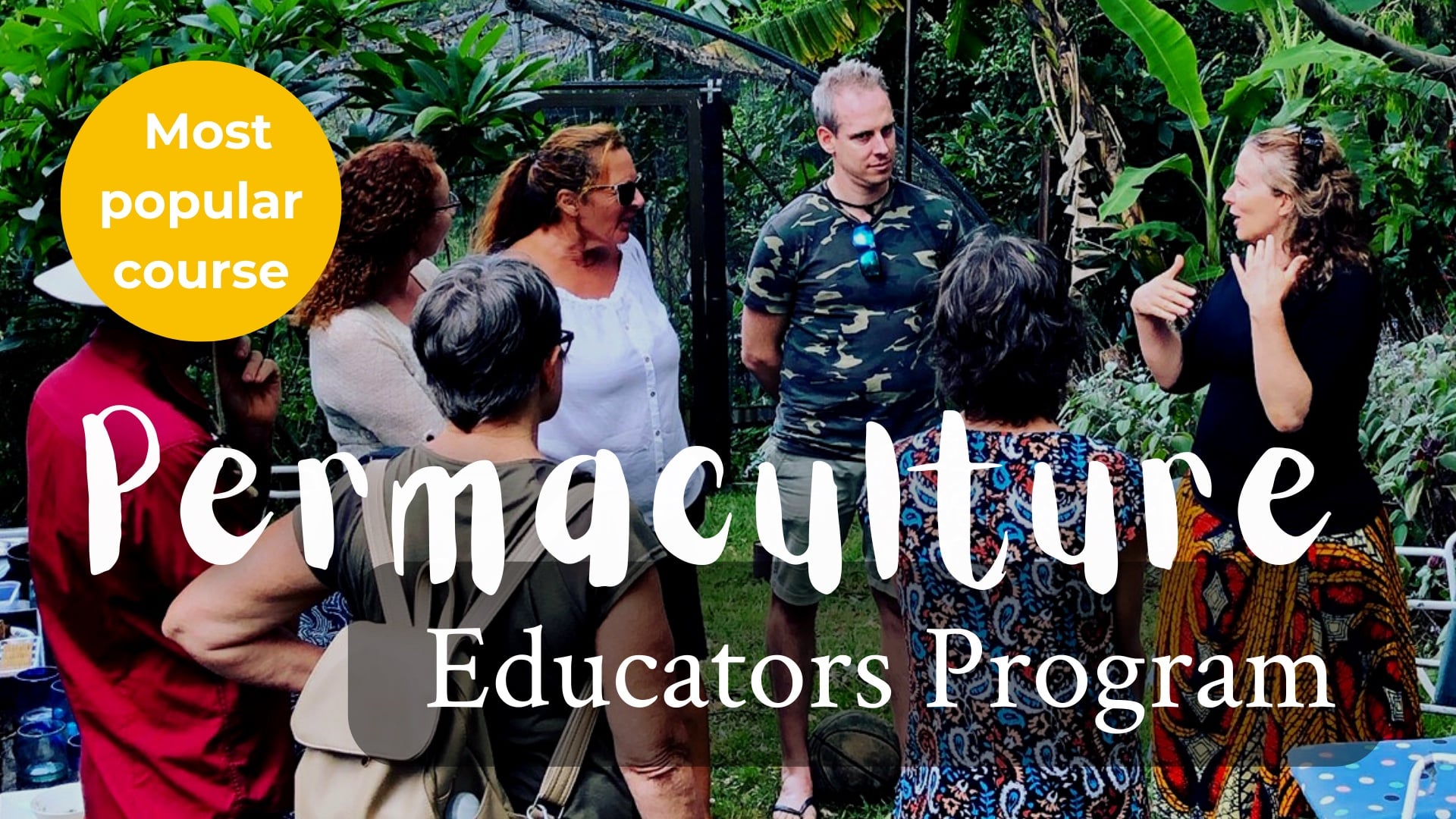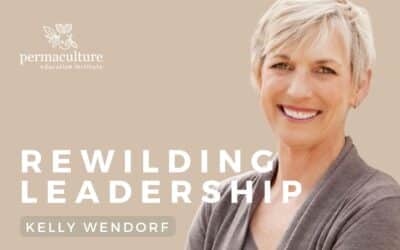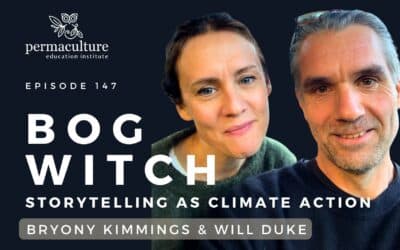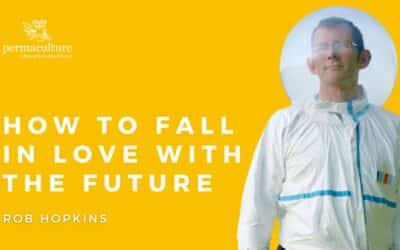Enjoy this episode of Sense-Making in a Changing World – a conversation between Morag Gamble and Elspeth Hay. Elspeth shares a new an ancient story about perennial nut trees, our ecological role as humans, and the future of food.
Below is a lightly edited conversation from the Sense-Making in a Changing World podcast, where I spoke with writer and radio host Elspeth Hay about her new book, Feed Us with Trees: Nuts and the Future of Food.
Meeting Elspeth and her nut-tree stories
Morag: Elspeth, thank you so much for joining me. I’ve just been immersed in your book that has just come out, and I absolutely love it. I felt like I was nodding the whole way through – “yes, this, this, this.”
Having been a permaculture educator for over 30 years, these are the kinds of stories that circulate through the permaculture movement, but they’re not usually part of the main narrative we hear about food, farming, land, people and “wilderness”. You touch so many of these entangled stories in the book.
To begin, can you share where you’re calling in from, the title of your book, and what got you started writing it?
Elspeth: I’m calling in from Cape Cod, Massachusetts – this tiny spit of sand out into the Atlantic on the east coast of the US.
The book is titled Feed Us with Trees: Nuts and the Future of Food, and it’s been such a journey. It lived in my head for a long time and wouldn’t quite come out. I’m really grateful it’s with readers now and starting some of these conversations, because our stories around food production are so nuanced, layered and tangled, and I was really interested in gently untangling some of that.
Acorns as a lightbulb moment
Morag: One of the first things that really struck me was your story about acorns – that lightbulb moment of “we can eat acorns”.
In my classes I often talk about how, whether it’s pumpkins or mulberries or anything else, there are so many more edible parts than we tend to notice. There’s food all around us – we’ve just forgotten how to see it.
In your context, with oak forests all around you, that acorn moment really opened something up. Could you share a bit of that story?
Elspeth: I live in an oak forest now, and I grew up in Maine in another oak forest, but I’d always seen the forest as an impediment to food production – not as a place where there was much to eat.
As a kid I’d hear people say, when asked what Indigenous people ate before European colonists, “oh, nuts and berries”. That answer never made sense to me. I walked in the woods all the time and never saw nuts, and you certainly can’t live on berries.
So when I finally learned that we can eat acorns, I had this real lightbulb moment: there’s a really abundant nut that’s been in the woods my whole life, and no one ever told me. At that point I’d been interviewing people about food for almost 15 years, and not one person had mentioned eating an acorn. It was a total shock and it upended everything I thought I knew about growing food and how we interact with the living world around us.
Food everywhere – when you remember how to see it
Morag: That really connects with something I notice all the time. I live in an eco-village and raised my children surrounded by permaculture food forests – we’re used to food falling from trees.
I remember going into the city on our way to an urban agriculture conference. As we walked, we kept seeing food everywhere: pepper berries dropping, acorns everywhere. My daughter was collecting as we went.
I was meant to give the keynote, and I said to her, “I think you ought to start – come and show everyone all this food you’ve found along the way.” She absolutely rocked it. She was about seven. On her way there, she’d discovered acorns were edible – people were saying “you can’t eat acorns” and she was Googling away, replying “well, yes, you can.”
For her, that was a big lightbulb moment too – especially because acorns don’t occur in our native forests; they’re city trees here, but absolutely everywhere in that urban landscape.
What I also loved in your book is how you connect that acorn crack-in-the-story to the broader shift from nut food forests to industrial agriculture – and all the conquest, power, war and genocide that’s embedded in that transition, but rarely spoken about. That little crack lets us look in and ask: What is food? Why do we do it this way? How could we return to something more nourishing for people and planet?
Nut trees, keystone species and ancestral stories
Morag: You describe learning that acorns are food as the beginning of an “ancestral healing journey.” What unfolded as you followed nut trees back through history?
Elspeth: I discovered that people all over the northern hemisphere have been in relationship with oaks and other keystone nut trees for a very long time.
Keystone species, just to clarify for listeners, are as important to an ecosystem as the keystone in a Roman arch – take them out and the whole thing collapses. In much of North America, oaks are the top “life support tree”. They’re ecologically central. And people recognised that – in England, Greece, California, many cultures in Asia – tending these nut trees as food and habitat.
Then suddenly there’s this big gap in the story: “And now we don’t.” I wanted to understand what happened.
I got to know Ron Reed from the Karuk people in present-day northern California. His community still recognises acorns as food and tends oaks as a food crop. They call themselves “fix-the-world people”. By creating habitat for oaks and other keystone trees, they see their role as creating habitat for other species – being a life-giving force. That was so different from the stories I’d grown up with, including the idea, as James Boyce puts it, that we’re “born bad” – that humans just don’t fit ecologically and always destroy what we touch.
Following the nut trees led me into the history of internal colonisation in Europe – the enclosure of woodland commons, the separation of people from wooded food landscapes that had been tended collectively, and how that fed into the colonial capitalist machine that expanded across the world. It completely reshaped how I understood why so many of our ancestors left and what they’d lost.
Commons, colonisation and human habitats
Morag: I’m glad you bring in the commons, because enclosure is such a big part of the story – in Europe and here in Australia.
We were told a very particular story: that Indigenous people here were “hunter-gatherers”, and that the land we now call “wilderness” was untouched. In reality, as writers like Bruce Pascoe describe, this continent was one vast tended food forest, with each country like a bioregion with its own managed systems. Places we now label “wild” were in fact human habitats – people-places.
Your book really speaks to this idea of the commons as human habitat, and to questions like: Where do we belong? What is a human habitat where we truly fit? We carry a lot of guilt and a sense of not belonging. You also weave in the story of “original sin” – that taking food from a forest garden is somehow wrong – and you dig into the etymology of “culture” as cultivated plough-land rather than relating in a forest garden.
Could you say a little more about how this shaped your sense of human belonging?
Elspeth: When I looked up the word “culture”, I was really surprised to see it originally meant land cultivated with a plough. Then I revisited food stories that had shaped me – like Adam and Eve.
Here are two people in an abundant forest garden where everything they need comes from trees. Because Eve gets too curious, they’re kicked out and condemned to grow their food “from the dirt” forever as punishment. It’s a powerful story about leaving a food forest and being pushed into a ploughed, labour-intensive agriculture, framed as moral consequence.
Alongside that, my parents were birdwatchers, so we travelled all over Maine. They taught me how birds were perfectly adapted to each ecosystem – sapsuckers drilling neat rows in birch and maple, and so on. Then we’d go home and get our food from grocery stores tied to industrial farms destroying the very ecosystems those birds depended on.
Without fully realising it, I kept asking: “What’s wrong with us? Why don’t we belong here?” Over time I’ve come to question that supposed line between “human” and “natural” worlds. I don’t think that line is real. It’s been constructed to support a particular narrative of dominance.
Oaks, insects and humans as potential keystone species
Morag: You also talk about Doug Tallamy’s work, showing oaks as top “life support trees” for insects – and that really intersects with your learning about oaks needing human tending. It’s a powerful challenge to the idea that humans are always the problem.
Elspeth: Yes, my mum – who’s still a keen birdwatcher – was following Tallamy’s work on insects and host plants. He shows that oaks are one of the most important life support plants in many North American ecosystems. A few species are “heavy lifters” for insect life, which then supports so many others higher up the food web.
At the same time, I was learning that many cultures deliberately promoted oaks and that oaks need human tending to stay dominant. Without that, they get outcompeted by more shade-tolerant trees.
It led to this cascade of realisations: if these trees I’d always seen as “wild” actually need us in much the same way our farmed species do, then that bright line we draw between “wild nature” and “human systems” doesn’t hold.
When I looked at the history of national parks here, I saw that legislation to create a park almost always followed a bill removing Indigenous people. These landscapes we now call “wild and pristine” were shaped by Indigenous people. The wild–human divide was constructed to erase that and justify colonial control.
Fire, oak forests and doing our job well
Morag: Fire is a huge conversation here in Australia, and it’s woven through your book too – particularly cultural burning and cool fire in oak landscapes.
Elspeth: Because of what I was learning about oaks and fire, I actually trained in prescribed burning. On the eastern seaboard of North America, oaks are a mid-succession species. They don’t regenerate well in deep shade, so for thousands of years Indigenous peoples burned to maintain oak–hickory forest mosaics.
That mix has been dominant here for around 9,000 years despite big climate shifts – partly because of that fire tending. With modern fire suppression, oaks are struggling to regenerate.
Again, it chipped away at this idea that “wild trees” are better without us. In reality there’s this ancient relationship: we do our job with fire, which benefits the oaks; they feed us and countless other beings. Being part of prescribed burns now, going out with Mass Fish and Wildlife, is incredibly fun and deeply interesting – and it’s also a way of stepping back into that role with some humility.
Language, acorns and the memories inside words
Morag: In the book you also dive into language – the many different words in Indigenous languages for acorns and acorn preparations, and what’s lost when English collapses all of that into one little word.
I feel this too with plants like pumpkins: we don’t have rich everyday words for shoots, flowers, leaves, tendrils, all the edible bits. To shift into a different relationship with tree foods and perennial polycultures, it feels like we need more language, more nuance.
Elspeth: Yes. When I started talking with people about acorns in California, Minnesota, Greece, England – I quickly realised “acorn” can mean very different things. There are more than 600 oak species, so my acorn and yours might behave completely differently in the kitchen.
I’d try a recipe and it wouldn’t work at all because the species I had was different. I learned I needed to ask, “Which oak are you using? What do the acorns look like?” Even inside that single English word, there’s enormous nuance.
I spoke with forager Sam Thayer about acorn processing. In northern California, where people use tanoak acorns, you might pour water through the flour four times and the tannins are gone. With northern red oak acorns in Maine, you might have to pour water through 75 times. Completely different chemistry, different traditions.
I found a mid-20th-century map of acorn processing methods across Indigenous North America – each method tuned to local species and conditions. Alongside that, I discovered the Old English word “mast” for nut crops, coming from the Gothic mat, meaning “food”. So even though much cultural knowledge has been lost, our language still holds these little memories of what nut forests once meant to us.
Commons Keepers and rooted lives
Morag: Toward the end of our conversation you share a project that really stood out to me: Commons Keepers. To me it’s such a beautiful way of bringing people into relationship with place.
Elspeth: A friend and I received a grant from the Provincetown Commons Changemakers Fund to host an initial gathering of young women called the Commons Keepers. We focused on water.
We spent four days walking and learning with wild-harvest shellfisherwomen, a salt-marsh restoration ecologist, plant medicine makers. We wove baskets. We did ceremony around water.
The aim was to challenge that dominant story of “success” – that success means leaving where you grew up, going to a city, getting a big job. We wanted to offer an alternative vision: staying rooted in place, tending commons and choosing careers in environmental stewardship as a meaningful, beautiful, viable path.
Radical regenerators and new stories of food
Morag: One of the things that really sings through your work is this idea that we can belong – that we can be what I like to call “radical regenerators”.
We talk about old wives’ tales and Indigenous stories, and how often they’re dismissed. You suggest pausing and asking: what might be true here, what might we have overlooked?
Elspeth: Exactly. I think we’re in a humbling and exciting moment. Science is now catching up with things many cultures have known for a long time – from mother trees communicating underground to oaks as true “trees of life”.
When I hear someone dismiss something as an “old wives’ tale” now, I’m curious: what knowledge might be encoded there?
Through this whole process, my default question has shifted from “How are we hurting the environment now?” to “How are we helping?” That doesn’t mean pretending everything we do is good – pouring oil on the ocean is not helpful – but it does mean learning the life cycles of species around us and asking where we might actually fit in ways that increase life rather than diminish it.
Morag: Yes – we can be radical regenerators. Feeling that sense of positivity about being human-in-place can be a motivating force to connect more deeply, observe more carefully, be playful and generous with the stories we tell and the experiments we make.
——
Advance Praise for Feed us with Trees
“How would you like to live in a world where biodiversity is increasing rather than disappearing, where more carbon is being stored in the ground than is being pumped out of the ground, where ocean dead-zones and topsoil loss are things of the past, and where diet- related health problems are exceptions, rather than the norm? With irrefutable logic, excellent prose, and meticulous research, Elspeth Hay describes such a world. It is not fantasy; it is the future!” —Douglas Tallamy, author, Nature’s Best Hope
“This book—I guarantee it—will blow your mind. Twenty pages in and you’ll be looking at the world in different ways.” —Bill McKibben, author, Here Comes the Sun!
“The nut tree is the king of the forest. This is the ‘bush food,’ eaten by the First Nations for millennia. The nut meat supplies folded sugars, essential fatty acids, and first class proteins. To understand the importance of this in our food stream would make anyone’s life unravel. Thank you Elspeth Hay and Feed Us with Trees.” —Dr. Diana Beresford-Kroeger, author of Our Green Heart, the Soul and Science of Forests
“Elspeth Hay’s compulsively readable book reveals just how deeply entangled we humans have always been with commoning the earth, and why we need to rediscover this lost way of life. Let us re-learn how to steward trees with loving care and subtle intelligence, and they will gift us many times over with untold treasures!” —David Bollier, author, Think Like a Commoner
Where to find Elspeth’s book – and where this meets permaculture
Morag: For people who’d like to read more, where can they find Feed Us with Trees – and what’s next for you?
Elspeth: The book is available online through most major booksellers, and in bookshops in the US. If you’re elsewhere, you can ask your local bookshop to order it in through New Society Publishers, who have a great online bookshop. It’s also on the big platforms.
Now that the book is out, I’m really enjoying moving from research and writing into more hands-on play – experimenting with cooking different nuts, making my own acorn flour, planting about 200 chestnut trees on land we have in Maine, and getting to know more so-called “wild” food and basketry species in my home place.
You can find Elspeth and her book at:
elspethhay.com
An invitation from Morag
For me, this conversation sits right at the heart of permaculture and the work we’re doing through the Permaculture Education Institute – asking how we design healthy human habitats where people, trees, insects, birds and soil all thrive together.
If Elspeth’s stories have stirred something in you and you’d like to go deeper into designing and teaching in this way, you’re very welcome to explore the Permaculture Educators Program – our online double-certificate program where you study your Permaculture Design Certificate and Permaculture Teacher Certificate together, in a global community of practice.
We explore food forests, agroecology, commons, local economies and the craft of teaching – and we keep circling back to questions like the ones in this conversation:
-
What is food?
-
How can our presence be a gift to the ecosystems we live in?
-
How do we become good ancestors in our own bioregions?
You can find out more here:
Permaculture Educators Program – Permaculture Education Institute
ABOUT THE PODCAST
The Sense-Making in a Changing World podcast is an initiative of the Permaculture Education Institute hosted by Morag Gamble. It is broadcast from a solar powered studio in the midst of a permaculture ecovillage food forest on beautiful Gubbi Gubbi country.
We explore ‘what now’ – what thinking do we need to navigate a positive and regenerative way forward; what does a thriving one-planet way of life look like; and where should we putting our energy.
🎧 Listen to Sense-Making in a Changing World wherever you get your podcasts.
Tune in on Spotify, Apple Podcasts, Youtube or any of your preferred podcast platforms.
Subscribe, share, comment and leave a ⭐⭐⭐⭐⭐ review if you enjoy and keep this podcast myceliating!
ABOUT THE PERMACULTURE EDUCATION INSTITUTE
Morag Gamble, founder of the Permaculture Education Institute, is an award-winning permaculture teacher, humanitarian, writer, film-maker and designer who has led programs for 3 decades in over 22 countries. She is an international leader of the permaculture movement for change.
The Permaculture Education Institute works with people on six continents, teaching permaculture design and skills. how to be a permaculture teacher and community leader, and how to create a regenerative permaculture livelihood. You can start our courses today.
Visit our website to find out more.





0 Comments